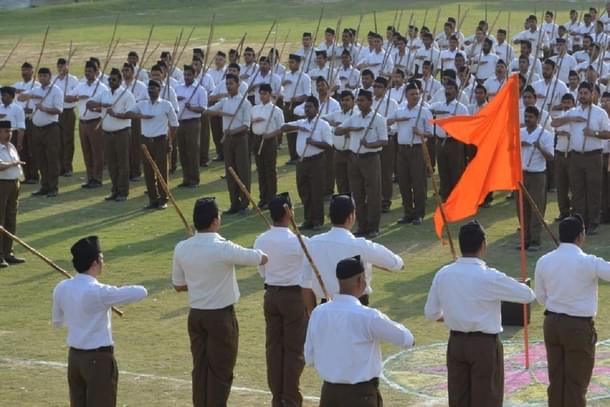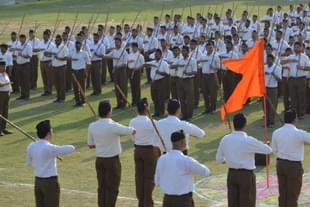Ideas
No Compromises Please: Why The RSS Should Reject Any And All Caste Apologia
Aravindan Neelakandan
Aug 13, 2024, 01:47 PM | Updated 01:46 PM IST
Save & read from anywhere!
Bookmark stories for easy access on any device or the Swarajya app.


The Indian Express recently highlighted a provocative editorial from the Rashtriya Swayamsevak Sangh (RSS)-affiliated magazine Panchajanya.
Authored by editor Hitesh Shankar, the editorial boldly asserts that the caste system has served as a unifying force in India. The piece further claims that the British colonialists viewed the caste system as a significant impediment to their imperial ambitions in India, while the Mughals never understood it.
This unapologetic defence of the caste system is a more serious issue than the controversy it stirs. It is symptomatic of a deeper problem in the RSS.
The editorial in question is both anti-democratic and pseudo-historical, with each of its claims being easily refutable.
While caste undeniably acts as a unifying phenomenon across India, it remains a significant social problem rather than a positive force for unity. Caste divisions fragment society, counteracting the forces that could unite Hindu society into an organic nation.
The Mughals understood the caste system and leveraged it to the financial advantage of their empire. However, movements that rose against the Mughals, such as the Maratha, Khalsa, and Satnami, showcased a Dharmic unity among people across communities, much to the discomfort of the Mughals.
The British, on the other hand, saw caste as an opportunity rather than a challenge. Colonialists and evangelicals perceived caste as a civilisational deficiency of the Hindus, which they used to justify their evangelical and imperialistic missions.
Contrary to the claims in the article, it is the RSS that has a problem here in understanding caste. This is a systemic issue and a deeply concerning one for the future of Hinduism.
The time has come to discuss this openly. This is because the RSS stands as the only pan-India organisational hope for Hindu survival and revival. If the Hindus are to ever experience a true renaissance, it will likely be through the RSS. The organisation has made remarkable strides against all odds, achieving what once seemed nearly impossible.
That is precisely the reason why the current ambiguous stance of the RSS on caste must be critically examined and addressed.
A simple Google search will reveal a few videos of RSS' ‘Guruji’ Golwalkar and songs glorifying him, even pre-Independence era videos of Dr Hedgewar, the RSS founder. Yet, finding videos of Madhukar Dattatreya Deoras, the third all-India leader of the RSS, is rare.
Deoras, who guided the organisation through the Emergency, the Janata crisis, the Ekatmata Ganga Yatra, and the crucial years of the Shri Ram Janmabhoomi movement, was a strong critic of the caste system. His contributions and critiques deserve more visibility and recognition.
In the early days of his leadership, during the Vasant Vyakhyanmala (Spring Lecture Series) in May 1974, Deoras delivered a thought-provoking address. He drew upon the often-overlooked writings of Dr Ambedkar, highlighting a core critique of Hindu society: despite possessing the spiritual foundation for democracy through the Upanishadic Mahavakyas, Hindus had failed to restructure their society accordingly.
This bold stance earned Deoras considerable criticism, with some whispering behind his back that he was an atheist and a communist within the Sangh. He was aware of those whispers, yet his humanist ideals continued to shape the organisation and drive its expansion.
But the RSS is far from being a monolith. It in a way reflects Hindu society, which has a noticeable 'savarna' bias in both its composition and outlook.
Deoras endeavoured to shift this perspective, achieving significant success but also encountering substantial obstacles.
Deoras made Dr Rajendra Singh, a physicist and non-Brahmin, the fourth all-India leader of the Sangh. That in the hundred-year history of this pan-Hindu movement, only one non-Brahmin could become its all-India leader is a telling indicator.
The next leader was Sudarshan. The forces that were waiting for their time seized their moment when Sudarshan ascended as the all-India leader of the RSS. Despite sharing Deoras’ values, Sudarshan’s influence waned during his tenure.
This period saw the emergence of a pernicious theory from the southern branches of the RSS — justifying caste as social capital.
The power elite of the Sangh Parivar in the south were predominantly upper-caste, with Brahmin strategists at the forefront. They were caught between Dravidianist, anti-Brahmin rhetoric and a worldview that upheld birth-based varna as Sanatana Dharma. Sponsored studies at management schools, academic papers, and pamphlets propagated this idea, leading to an increasing infiltration of pro-casteist views within the Sangh’s vision.
Though fringe in academia, the caste-as-social-capital theory soon became part of the worldview of sections of influential RSS thinkers.
That apart, the Sangh structure itself had an early-advantage savarna composition. Most, if not all, of the editors of magazines like Organiser and Panchajanya belonged to the group. Often, they seemed unaware of or indifferent to the struggles of Avarna Hindus.
When a renaissance RSS cadre or a Sangathanist Hindu speaks of ‘Sanatana Dharma,’ he or she refers to the vision brought to life by saints and seers like Dayananda Saraswati of Arya Samaj, Swami Vivekananda, Mahatma Gandhi, and Veer Savarkar.
In contrast, the non-Sangathanist traditionalist view of 'Sanatana Dharma' includes the birth-based varna system, justification and practice of untouchability in various forms, a glorified era of child marriage, opposition to women's education, and strict limitations on widows.
Unfortunately, this caricatured version of Sanatana Dharma is the same one used by its detractors.
While the RSS largely upholds the former vision, some strategically placed elements within the organisation attempt to promote the latter.
If the RSS does not address casteism within its ranks, all its great works and achievements will be tainted. The Dharmic will of the likes of Pandit Deendayal Upadhyaya comes with the simple life and high thinking of the early Swayamsevaks — the ones whom we saw and admired in our formative ages.
It is time for the RSS to return uncompromisingly to its roots.




